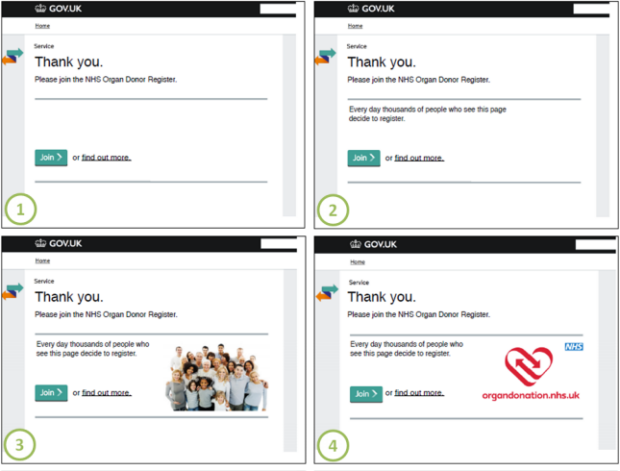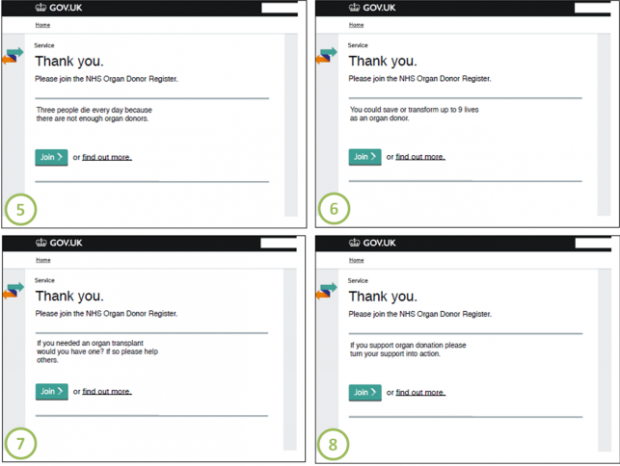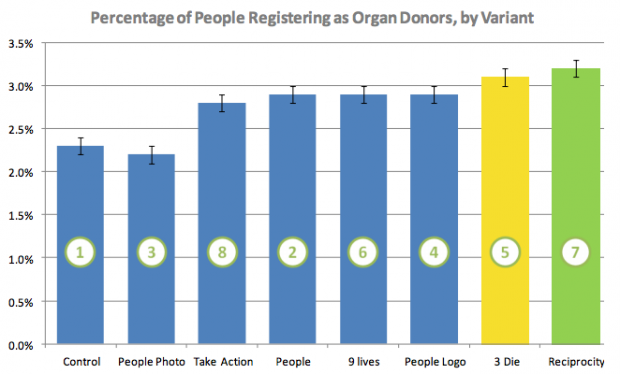Last autumn we shared early results of testing various versions of the GOV.UK 'Thank You' page. First introduced a year ago, people see this page once they've bought their tax disc via GOV.UK. People are generally more open to trying out new stuff after completing a successful transaction, so we've been using this page to encourage as many as possible to join the NHS organ donation register.
Over 350,000 people have now registered for organ donation via this one link on GOV.UK [since Jan 2013]
Via a comment on that earlier blog post, Claire reminded me recently that we'd not shared the final results of the experiment, notably which type of message was most effective at persuading people to register.
What we tested
Working with the Cabinet Office Behavioural Insights team, DVLA and NHS Organ Register team, we tested eight different calls to action with a total of over 1,000,000 visitors to the tax disc 'Thank You' page.
The eight variants below appeared at random, and we worked closely with the NHS Organ Donation team to see which one generated the most completed registrations. This is known as A/B testing.


What we found
Here are the results, showing which variant was most effective at getting people to actually register for organ donation. The percentages are not just for click-throughs; they're actual organ donor registrations.
The most successful variant introduced concepts of reciprocity and fairness by asking people: “If you needed an organ transplant, would you have one? If so please help others.”
I don't feel qualified to speculate as to the reasons why this particular message performs best - data trumps intuition. But, feel free to add your thoughts via the comments below.
We ended the experiment in the autumn, and have left this "reciprocity" message in place. Meanwhile, the new digital team at DVLA has got on with updating the tax disc service.
Since the DVLA tax disc online service is used by around 2m people every month, the impact of such optimisation is significant.
Extrapolated over 12 months, some 96,000 more people will register compared with the original call to action. ("Please join the NHS Organ Donor Register"). In December the former Cabinet Office Behavioural Insights team published a paper with more statistical detail on the experiment.
In total over 350,000 people have registered for organ donation via this one link on GOV.UK since we added the original call to action just over a year ago.
Stuff worth doing.
Follow Tom on Twitter, join the wider conversation with @GDSTeam and don't forget to sign up for email alerts.



16 comments
Comment by o-boulo.com posted on
Any initiative to increase organ donation should be praised. Well done!
Comment by claire toplis posted on
wow over 350,000 what a great job , here is to many mores
Comment by abpmr posted on
Over 350,000, this is awesome! Great test and a great contribution to the society.
Comment by David posted on
Over 350,000, this is awesome! Great test and a great contribution to the society.
Comment by Michael posted on
Very interesting article and what a great result.
I am sure the author and others know that the importance of reciprocity as a stimulus to action was identified and popularised by Prof Robert Cialdini (RSA has great audio of his lecture.)
Cialidin also highlights the importance of "social proof" : we are likely to do the same things that other people do, when we identify them as being similar to us in some relevant respect.
So on his basis it would be interesting to see if you got an increase in conversions by saying at bottom of current page, something like
Since March 2013 over 350,000 people who came here to buy a tax disc have registed as organ doners.
Comment by Sara posted on
It is good to see that online marketing is doing some thing positive and contributing to the society. Good effort.
Comment by Dev posted on
It is good to know that AB testing is doing something great especially when it comes to humanitarian ground
Comment by Keith C posted on
You might get wear out idc so can be useful to rotate. This, from 1983, is pretty useful guide to copy-testing
http://www.amazon.co.uk/Ogilvy-Advertising-David/dp/1853756156 (er - other retailers are available)
Keith
Comment by Phil posted on
Wow, so you got a conversion rate of 22% of all viewers of the thank you screen. That's pretty good!
Comment by john posted on
I wish that were true, but you can't add the percentages without dividing by 8.
Comment by Tom Loosemore posted on
John's right - the average conversion from the thank you page to a *completed* registration is around 3%, not 22%. I'm not surprised at such levels of conversion. Even if interested in signing up, not everyone is ready to register there and then, and the process itself asks for quite a bit of information to be filled in. See https://www.organdonation.nhs.uk/how_to_become_a_donor/registration/consent.asp
Comment by Christopher Fahey posted on
John: 3% of people who *saw this screen* went on to actually finish signing up for organ donation. It doesn't matter what path they took to get there. So to answer your second question, the variant with the most sign-ups *is* the one with the highest percentage of people who signed up.
Comment by john posted on
Thanks for the clariifcation. But that suggests that six of the variants had very similar success, I wonder if that means there's a limit to the conversion rate or if that there may be room for tweaking the design to get an even higher response.
Comment by Christopher Fahey posted on
Great test. That said, my intuition said that 5 and 7 would have been the best, so for me at least data didn't actually trump intuition. 🙂
Comment by john posted on
Also, I notice that variant three with the logo performed well, but you didn't test it with alternative wordings. Given it's such an important cause, might it be worth adding the logo to the successful wording variant and see if you get better results?
Comment by john posted on
Great initiative, but I'm confused by youer explanation.
Option 7 was most successful because it achieved a sign-up rate of just over 3%. 3% of what? 3% of people who clicked through on that option or 3% of all click throughs?
Isn't the most successful variant, simply the one that yields the most sign-ups rather than a percentage?